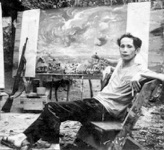Copyright © 1986-2016, Witness Collection and other copyright holders. All rights reserved.
Images and content on this site may not be reproduced in any form without prior written consent from Witness Collection.
For information about exhibitions, loans, internships or other forms of collaboration, please email us via the contact us page.

In 1954, after the defeat of the French at Điện Biên Phủ, Huân returned to Hanoi and was rewarded with a one year trip to Eastern European countries. At the end of his stay, with the authorities needing skilled staff for cinema, he was asked to go to the Soviet Union to study art design at several leading cinema schools. He returned to Vietnam in 1959 where he taught cinema art design. After studying at the Nguyễn Ái Quỗc political institution for key communist party members, in 1964, Huân was commissioned to return to the south of Vietnam to manage the ‘liberty art department’. Due to the secrecy of the assignment, his name was changed to Thái Hà. From 1964, until the end of the war in 1975, Thái Hà lived and worked primarily in the south, creating many sketches and images of the daily life of villagers and soldiers. Alongside artists Huỳnh Phương Đông, Trang Phượng and Nguyễn Thanh Châu, his works became some of the most widely published and exhibited from the war.
As a specialist in lacquer painting and coromandel, Thái Hà created many small lacquer works that were given to foreign delegations as gifts by diplomats in Hanoi between 1971-75. After the war ended, he became deputy head of the Ho Chi Minh City Fine Arts Association and a full-time artist after 1999. He is widely recognised as one of Vietnam’s most talented coromandel (engraved lacquer) artists. He died on 12 October 2005.
Thái Hà
